Nursing Care Plan for Hypertension and Related Diseases: Analysis
VerifiedAdded on 2020/07/22
|16
|4528
|67
Report
AI Summary
This report details an individual care plan for a patient with hypertension and related diseases, focusing on diagnosis, patient assessment, and pharmacology. The introduction defines hypertension and its global impact, highlighting unhealthy eating habits, obesity, and smoking as major contributing factors. Task 1 covers the diagnosis of hypertension, including physical examinations, blood pressure measurements, and the role of various diagnostic methods like glucose and lipid level tests. The pathophysiology of hypertension and its effects on various organs are also discussed. The patient care plan, developed by a nurse, addresses the patient's profile, nursing assessment, and identification of problems. The assessment includes the patient's lifestyle, smoking habits, and clinical reports, leading to a nursing diagnosis. The care plan emphasizes weight reduction, smoking cessation, and dietary modifications to manage hypertension and improve the patient's health. The report provides a comprehensive overview of hypertension management, offering valuable insights for healthcare professionals and students.
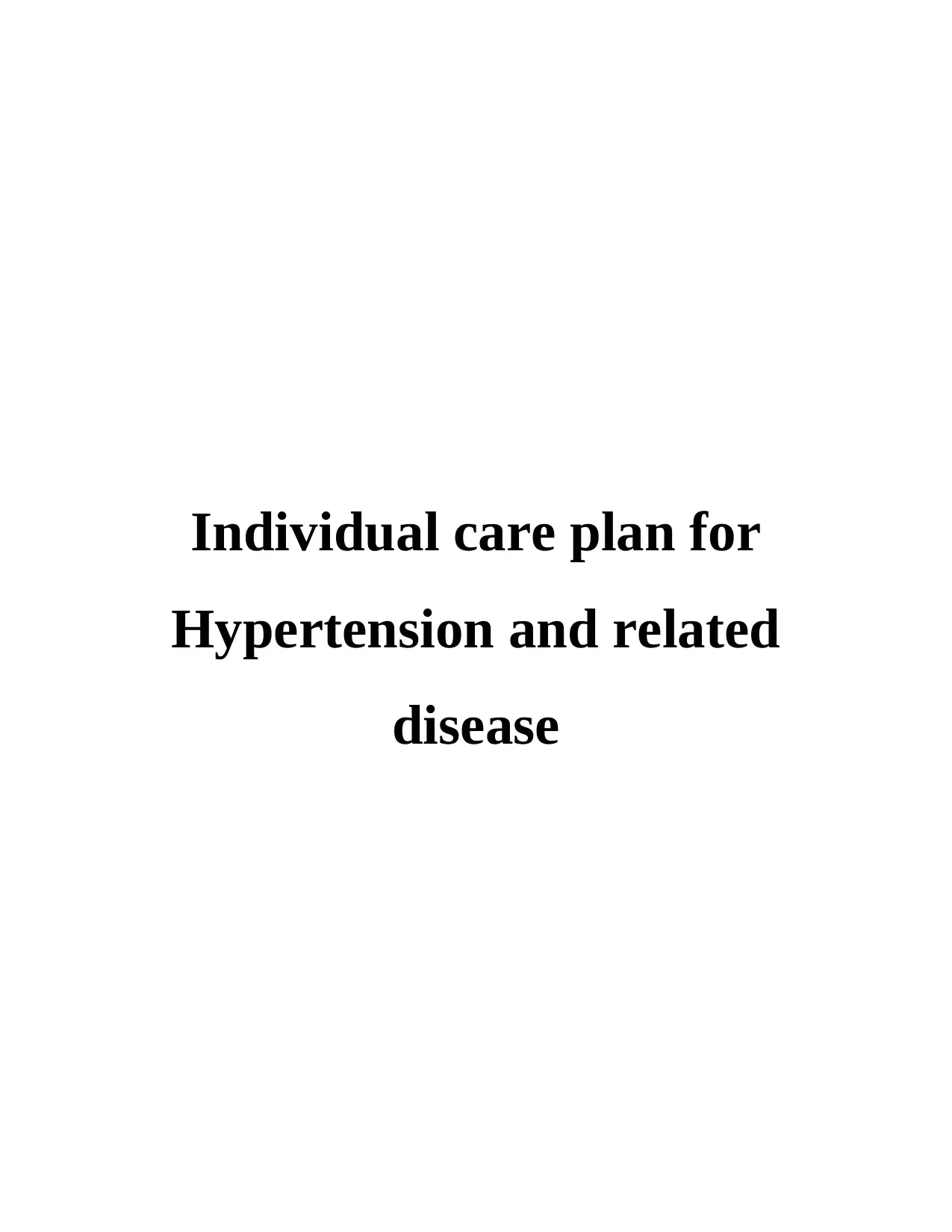
Individual care plan for
Hypertension and related
disease
Hypertension and related
disease
Paraphrase This Document
Need a fresh take? Get an instant paraphrase of this document with our AI Paraphraser

TABLE OF CONTENTS
INTRODUCTION...........................................................................................................................1
TASK...............................................................................................................................................1
1. Diagnosis and applied physiology......................................................................................1
2. Patient Care Plan................................................................................................................3
3. Related Pharmacology........................................................................................................9
CONCLUSION..............................................................................................................................10
REFERENCES..............................................................................................................................11
APPENDIX....................................................................................................................................13
INTRODUCTION...........................................................................................................................1
TASK...............................................................................................................................................1
1. Diagnosis and applied physiology......................................................................................1
2. Patient Care Plan................................................................................................................3
3. Related Pharmacology........................................................................................................9
CONCLUSION..............................................................................................................................10
REFERENCES..............................................................................................................................11
APPENDIX....................................................................................................................................13

INTRODUCTION
Hypertension can be defined as higher blood pressure of person. The systolic and
diastolic blood pressure of a healthy person is between 120/80 mm Hg. As a nurse professional
by analysing patient BP it can be defined that if person's systolic pressure exceeds form 120 to
140 than patient is suffering from hypertension. About 7.5 million people are dying due to higher
blood pressure and disease i.e. 12.8% of total death annually in world according to report of
world health organisation. In my nursing career and during my internship in hospital I have
observed that major cause of disease is unhealthy eating habits, obesity, smoking etc. The long
term disease can leads to cancerous disease in particular patient (Delles and et. al., 2010). I am
assessing a patient suffering from hypertension during my training period of nursing career in
Hong Kong. My analysis report studies an middle age male patient suffering from lower cardiac
output and higher blood pressure and considered to study nursing care plan for particular
disease problem and other related disease. The patient is considered because person is having
unhealthy eating habits, often go for outside food and I assisted in my risk assessment report of
patient that he is also suffering from obesity in which proper nursing take care plan is studied.
The learning outcome from this report can be extracted that person will get to know about dietary
plans, weight reduction plans to maintain his health life helping in reducing hypertension.
TASK
1. Diagnosis and applied physiology
The diagnosis of increased blood pressure is carried out by identifying any damage to
internal organs in patient of hypertension and its related disease. The diagnosis's procedure
carried out by me as a nursing professional in along with doctor include testing person blood
pressure, vascular permeability and content and viscosity of blood and level of obesity. I have
observed from intake of risk assessment that patient is suffering from high blood pressure and
obesity. The salt content is increased in hypertension pressure (Galiè and et. al., 2015). There are
different diagnosis methods in order to generate a report for patient suffering from disease. There
are different level of blood pressure defined as hypertension according to age and sex of patient.
Physical examination and different test like Sphygmomanometers carried out by me in order to
analyse the various symptoms and disease related to hypertension to identify etiology and
pathophysiology of individual. Blood pressure is dependent on activities after which it is
1
Hypertension can be defined as higher blood pressure of person. The systolic and
diastolic blood pressure of a healthy person is between 120/80 mm Hg. As a nurse professional
by analysing patient BP it can be defined that if person's systolic pressure exceeds form 120 to
140 than patient is suffering from hypertension. About 7.5 million people are dying due to higher
blood pressure and disease i.e. 12.8% of total death annually in world according to report of
world health organisation. In my nursing career and during my internship in hospital I have
observed that major cause of disease is unhealthy eating habits, obesity, smoking etc. The long
term disease can leads to cancerous disease in particular patient (Delles and et. al., 2010). I am
assessing a patient suffering from hypertension during my training period of nursing career in
Hong Kong. My analysis report studies an middle age male patient suffering from lower cardiac
output and higher blood pressure and considered to study nursing care plan for particular
disease problem and other related disease. The patient is considered because person is having
unhealthy eating habits, often go for outside food and I assisted in my risk assessment report of
patient that he is also suffering from obesity in which proper nursing take care plan is studied.
The learning outcome from this report can be extracted that person will get to know about dietary
plans, weight reduction plans to maintain his health life helping in reducing hypertension.
TASK
1. Diagnosis and applied physiology
The diagnosis of increased blood pressure is carried out by identifying any damage to
internal organs in patient of hypertension and its related disease. The diagnosis's procedure
carried out by me as a nursing professional in along with doctor include testing person blood
pressure, vascular permeability and content and viscosity of blood and level of obesity. I have
observed from intake of risk assessment that patient is suffering from high blood pressure and
obesity. The salt content is increased in hypertension pressure (Galiè and et. al., 2015). There are
different diagnosis methods in order to generate a report for patient suffering from disease. There
are different level of blood pressure defined as hypertension according to age and sex of patient.
Physical examination and different test like Sphygmomanometers carried out by me in order to
analyse the various symptoms and disease related to hypertension to identify etiology and
pathophysiology of individual. Blood pressure is dependent on activities after which it is
1
⊘ This is a preview!⊘
Do you want full access?
Subscribe today to unlock all pages.

Trusted by 1+ million students worldwide
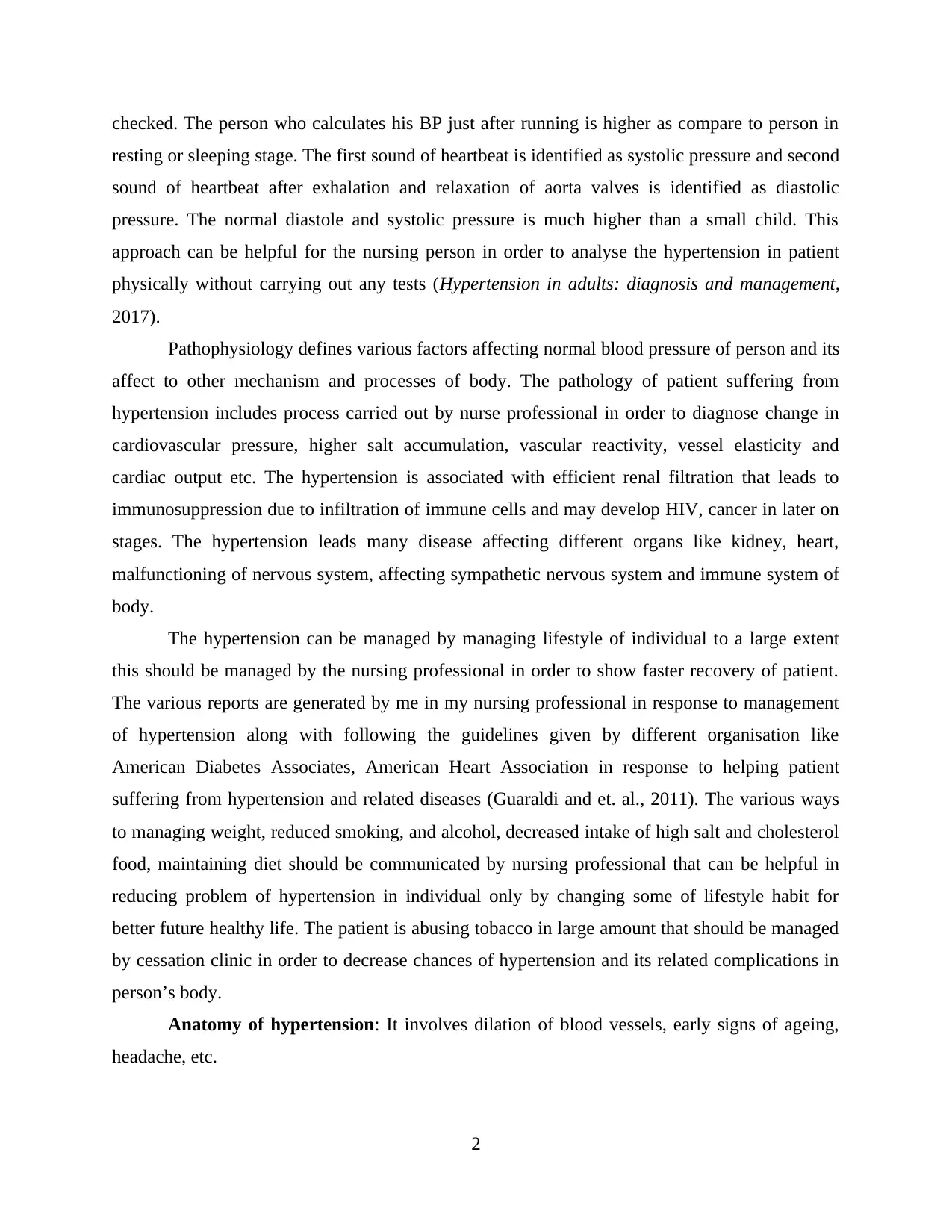
checked. The person who calculates his BP just after running is higher as compare to person in
resting or sleeping stage. The first sound of heartbeat is identified as systolic pressure and second
sound of heartbeat after exhalation and relaxation of aorta valves is identified as diastolic
pressure. The normal diastole and systolic pressure is much higher than a small child. This
approach can be helpful for the nursing person in order to analyse the hypertension in patient
physically without carrying out any tests (Hypertension in adults: diagnosis and management,
2017).
Pathophysiology defines various factors affecting normal blood pressure of person and its
affect to other mechanism and processes of body. The pathology of patient suffering from
hypertension includes process carried out by nurse professional in order to diagnose change in
cardiovascular pressure, higher salt accumulation, vascular reactivity, vessel elasticity and
cardiac output etc. The hypertension is associated with efficient renal filtration that leads to
immunosuppression due to infiltration of immune cells and may develop HIV, cancer in later on
stages. The hypertension leads many disease affecting different organs like kidney, heart,
malfunctioning of nervous system, affecting sympathetic nervous system and immune system of
body.
The hypertension can be managed by managing lifestyle of individual to a large extent
this should be managed by the nursing professional in order to show faster recovery of patient.
The various reports are generated by me in my nursing professional in response to management
of hypertension along with following the guidelines given by different organisation like
American Diabetes Associates, American Heart Association in response to helping patient
suffering from hypertension and related diseases (Guaraldi and et. al., 2011). The various ways
to managing weight, reduced smoking, and alcohol, decreased intake of high salt and cholesterol
food, maintaining diet should be communicated by nursing professional that can be helpful in
reducing problem of hypertension in individual only by changing some of lifestyle habit for
better future healthy life. The patient is abusing tobacco in large amount that should be managed
by cessation clinic in order to decrease chances of hypertension and its related complications in
person’s body.
Anatomy of hypertension: It involves dilation of blood vessels, early signs of ageing,
headache, etc.
2
resting or sleeping stage. The first sound of heartbeat is identified as systolic pressure and second
sound of heartbeat after exhalation and relaxation of aorta valves is identified as diastolic
pressure. The normal diastole and systolic pressure is much higher than a small child. This
approach can be helpful for the nursing person in order to analyse the hypertension in patient
physically without carrying out any tests (Hypertension in adults: diagnosis and management,
2017).
Pathophysiology defines various factors affecting normal blood pressure of person and its
affect to other mechanism and processes of body. The pathology of patient suffering from
hypertension includes process carried out by nurse professional in order to diagnose change in
cardiovascular pressure, higher salt accumulation, vascular reactivity, vessel elasticity and
cardiac output etc. The hypertension is associated with efficient renal filtration that leads to
immunosuppression due to infiltration of immune cells and may develop HIV, cancer in later on
stages. The hypertension leads many disease affecting different organs like kidney, heart,
malfunctioning of nervous system, affecting sympathetic nervous system and immune system of
body.
The hypertension can be managed by managing lifestyle of individual to a large extent
this should be managed by the nursing professional in order to show faster recovery of patient.
The various reports are generated by me in my nursing professional in response to management
of hypertension along with following the guidelines given by different organisation like
American Diabetes Associates, American Heart Association in response to helping patient
suffering from hypertension and related diseases (Guaraldi and et. al., 2011). The various ways
to managing weight, reduced smoking, and alcohol, decreased intake of high salt and cholesterol
food, maintaining diet should be communicated by nursing professional that can be helpful in
reducing problem of hypertension in individual only by changing some of lifestyle habit for
better future healthy life. The patient is abusing tobacco in large amount that should be managed
by cessation clinic in order to decrease chances of hypertension and its related complications in
person’s body.
Anatomy of hypertension: It involves dilation of blood vessels, early signs of ageing,
headache, etc.
2
Paraphrase This Document
Need a fresh take? Get an instant paraphrase of this document with our AI Paraphraser

Physiology of hypertension: It can be identified by increased cardiac output and higher
elasticity of blood vessels with neural excitation.
2. Patient Care Plan
The patient health care plan can be developed by nurse with help of professional health
care practitioner in order to reduce hypertension and higher BP in patent. The plan along with the
intake of nursing assessment and intervention includes various approaches to weight reducing
plan by managing healthy diet of patient. This health care plan also concentrate on reducing
addiction to drugs, alcohol and smoking and helps in balancing salt in balance in body of patient.
This helps in maintaining body fluid balance and normal blood pressure of body. This nursing
assessment involves health creating care plan for individuals suffering from hypertension. The
person is suffering from hypertension due to increased obesity, high addiction to smoking and
tobacco abuse.
A. Patient's Profile and Nursing assessment:
The patient for whom nurse is making health care plan is from Honk Kong suffering from
hypertension due to unhealthy eating habits, and smoking habit. This leads to cardiovascular
problem and cardiac output, imbalance in slat and cholesterol level of blood and increased blood
pressure. The patient age is around 50 years and sex is male. The hypertension range of mid age
patient is from 140 mm Hg approximately. Above this range person is suffering from
hypertension (Pauwels and et. al., 2012). Social life of patient affects hypertension level to large
extent. The person is living in Honk Kong city and more often in preferring outside food with
high fat content. The lifestyle of patient in society also affects normal blood pressure like
smoking and alcohol leads to increased blood pressure. The individual is renovation worker
which is a tensed task and involved exposure to smoke, dust that also affect normal blood
pressure of individual. In my nursing assessment report I assisted that patient is addictive to
smoking. He used to smoke about 13 cigarettes per day which affects the blood transfusion and
vascularity of blood vessels.
Clinical report of patient observed by nurse shows that person is regular smoker he used
to smoke 13 cigarettes per day. The obesity of person is found to be T82 and positive test
towards hypertension. BP of person is reported 134/88 mm Hg which is case of hypertension and
3
elasticity of blood vessels with neural excitation.
2. Patient Care Plan
The patient health care plan can be developed by nurse with help of professional health
care practitioner in order to reduce hypertension and higher BP in patent. The plan along with the
intake of nursing assessment and intervention includes various approaches to weight reducing
plan by managing healthy diet of patient. This health care plan also concentrate on reducing
addiction to drugs, alcohol and smoking and helps in balancing salt in balance in body of patient.
This helps in maintaining body fluid balance and normal blood pressure of body. This nursing
assessment involves health creating care plan for individuals suffering from hypertension. The
person is suffering from hypertension due to increased obesity, high addiction to smoking and
tobacco abuse.
A. Patient's Profile and Nursing assessment:
The patient for whom nurse is making health care plan is from Honk Kong suffering from
hypertension due to unhealthy eating habits, and smoking habit. This leads to cardiovascular
problem and cardiac output, imbalance in slat and cholesterol level of blood and increased blood
pressure. The patient age is around 50 years and sex is male. The hypertension range of mid age
patient is from 140 mm Hg approximately. Above this range person is suffering from
hypertension (Pauwels and et. al., 2012). Social life of patient affects hypertension level to large
extent. The person is living in Honk Kong city and more often in preferring outside food with
high fat content. The lifestyle of patient in society also affects normal blood pressure like
smoking and alcohol leads to increased blood pressure. The individual is renovation worker
which is a tensed task and involved exposure to smoke, dust that also affect normal blood
pressure of individual. In my nursing assessment report I assisted that patient is addictive to
smoking. He used to smoke about 13 cigarettes per day which affects the blood transfusion and
vascularity of blood vessels.
Clinical report of patient observed by nurse shows that person is regular smoker he used
to smoke 13 cigarettes per day. The obesity of person is found to be T82 and positive test
towards hypertension. BP of person is reported 134/88 mm Hg which is case of hypertension and
3

increased BMI up-to 25.70. The person is also suffering from Obesity about 73.40 kg. The ECG
report of person comes out normal.
Nursing Assessment Report: This report is developed by me in order to assess the
problem in health of patient and analyse various risk associated with particular disease. This is
followed by generation of various plans in order to helping patient to recover from hypertension
for better future health (Schmidt and et. al., 2011). This can be achieved by self-monitoring tools
of BP at home and managing life style and food habits according to recommendation of nurse
professional and doctor recommendation.
Nursing Assessment Form
Name Result Unit Remarks
CVD risk Low risk (<10%) NA There is no symptoms
seen in the analysis of
CVD in patient.
Use of BP monitoring No NA Patient do not know
about monitoring tools
of BP.
Alcohol Non-drinker NA Patient do not drink
any beverages
containing alcoholic
content.
ECG Normal NA Normal pulse rate
observed by nurse in
patient. Pulse rate is
81/min (slightly higher
than normal)
BP Higher 130/88 mm Hg Blood pressure higher
in patient report. This
shows early stage of
hypertension in
4
report of person comes out normal.
Nursing Assessment Report: This report is developed by me in order to assess the
problem in health of patient and analyse various risk associated with particular disease. This is
followed by generation of various plans in order to helping patient to recover from hypertension
for better future health (Schmidt and et. al., 2011). This can be achieved by self-monitoring tools
of BP at home and managing life style and food habits according to recommendation of nurse
professional and doctor recommendation.
Nursing Assessment Form
Name Result Unit Remarks
CVD risk Low risk (<10%) NA There is no symptoms
seen in the analysis of
CVD in patient.
Use of BP monitoring No NA Patient do not know
about monitoring tools
of BP.
Alcohol Non-drinker NA Patient do not drink
any beverages
containing alcoholic
content.
ECG Normal NA Normal pulse rate
observed by nurse in
patient. Pulse rate is
81/min (slightly higher
than normal)
BP Higher 130/88 mm Hg Blood pressure higher
in patient report. This
shows early stage of
hypertension in
4
⊘ This is a preview!⊘
Do you want full access?
Subscribe today to unlock all pages.

Trusted by 1+ million students worldwide

patient.
Smoking Higher addiction to
smoking
13 cigarette /day
Tobacco content P17
Higher smoking that
affects the
accumulation and
permeability of cell
membrane.
Patent demographic that shows that he is of 50 years male suffering from obesity, and
hypertension. He is consistent smoker that can be severe for his health. He is living in Honk
Kong city where he mostly prefer eating outside food of high content fat which is increasing
patients bad cholesterol in body.
B. Nursing Diagnosis and Identification of Patient’s Problems:
Diagnosis of disease by a nursing professional includes analysing the health problem by
different means of diagnosis like physical test, observation, verbal diagnosis and various test
related to internal mechanism of body (Safar & O'Rourke, 2012). Diagnostic study of a patient to
identify health issues includes the following results from different tests:
Glucose level: Hyperglycaemia can be identified by hypertension in patient. The
increased level of glucose in blood leads to increased concentration in blood and results in
disease. Hypertension and other related disease should be diagnosed by nurse by analysing level
of glucose level in blood in resting state before eating something.
Lipid panel: This test checks level of lipids present in blood and body fluids. Increased
level of lipid in blood also cause of hypertension and increased blood pressure in patient. This
identified by deposition of Arethroprotien and plague in body. That restricts blood flow and
affects blood pressure of body. The lab report and use assessment shows that patient is having
higher bad cholesterol in body due to unhealthy habit of eating patient. Person is preferring more
outside food having high fat content.
Thyroid studies: Higher amount of thyroid and thyroxine hormone in body leads to more
release of vasoconstrictor. This will affect the higher contraction in blood vessels and results in
elevated blood pressure. This can be diagnosed by nurse to identify problem of hypertension in
patient (Temple and Burkitt, 2012).
5
Smoking Higher addiction to
smoking
13 cigarette /day
Tobacco content P17
Higher smoking that
affects the
accumulation and
permeability of cell
membrane.
Patent demographic that shows that he is of 50 years male suffering from obesity, and
hypertension. He is consistent smoker that can be severe for his health. He is living in Honk
Kong city where he mostly prefer eating outside food of high content fat which is increasing
patients bad cholesterol in body.
B. Nursing Diagnosis and Identification of Patient’s Problems:
Diagnosis of disease by a nursing professional includes analysing the health problem by
different means of diagnosis like physical test, observation, verbal diagnosis and various test
related to internal mechanism of body (Safar & O'Rourke, 2012). Diagnostic study of a patient to
identify health issues includes the following results from different tests:
Glucose level: Hyperglycaemia can be identified by hypertension in patient. The
increased level of glucose in blood leads to increased concentration in blood and results in
disease. Hypertension and other related disease should be diagnosed by nurse by analysing level
of glucose level in blood in resting state before eating something.
Lipid panel: This test checks level of lipids present in blood and body fluids. Increased
level of lipid in blood also cause of hypertension and increased blood pressure in patient. This
identified by deposition of Arethroprotien and plague in body. That restricts blood flow and
affects blood pressure of body. The lab report and use assessment shows that patient is having
higher bad cholesterol in body due to unhealthy habit of eating patient. Person is preferring more
outside food having high fat content.
Thyroid studies: Higher amount of thyroid and thyroxine hormone in body leads to more
release of vasoconstrictor. This will affect the higher contraction in blood vessels and results in
elevated blood pressure. This can be diagnosed by nurse to identify problem of hypertension in
patient (Temple and Burkitt, 2012).
5
Paraphrase This Document
Need a fresh take? Get an instant paraphrase of this document with our AI Paraphraser
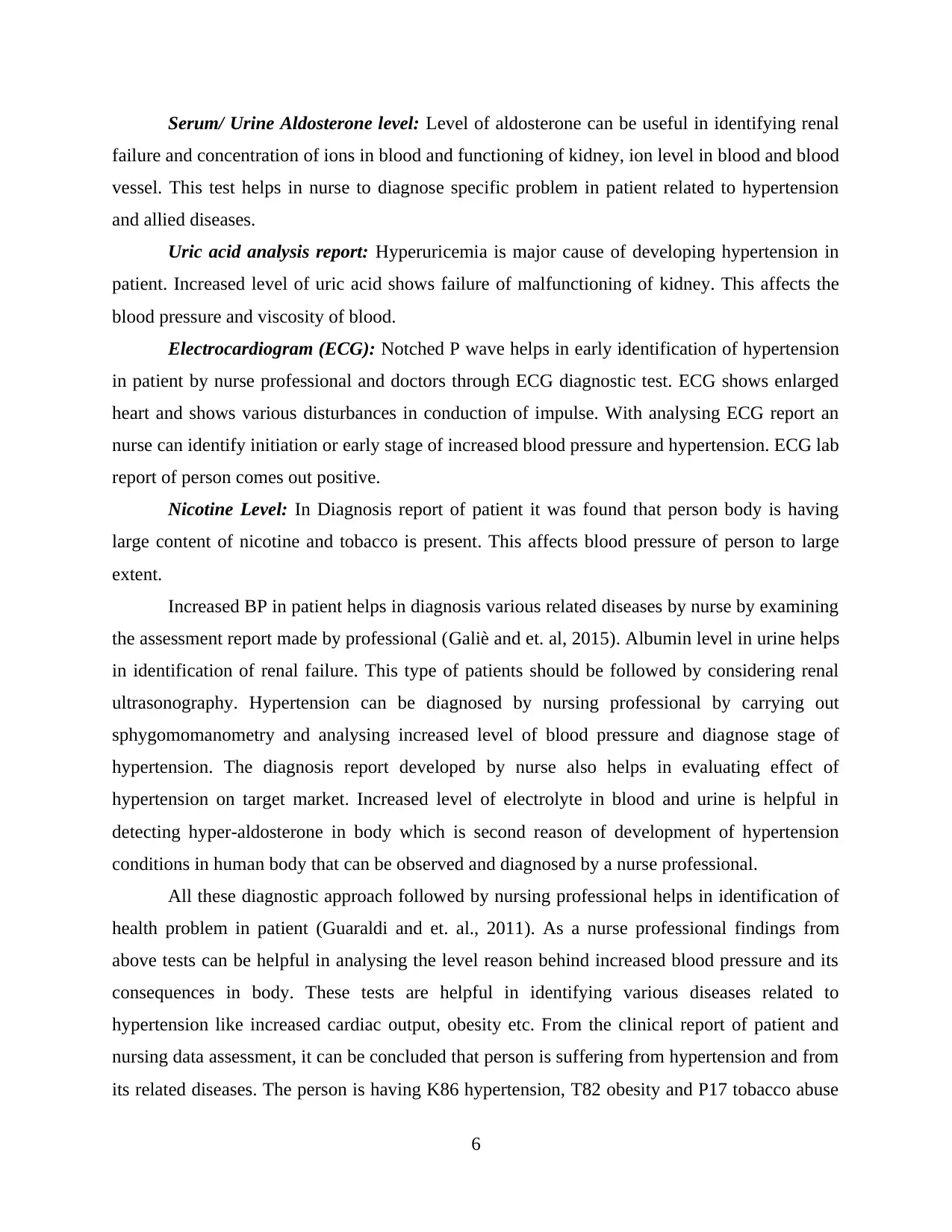
Serum/ Urine Aldosterone level: Level of aldosterone can be useful in identifying renal
failure and concentration of ions in blood and functioning of kidney, ion level in blood and blood
vessel. This test helps in nurse to diagnose specific problem in patient related to hypertension
and allied diseases.
Uric acid analysis report: Hyperuricemia is major cause of developing hypertension in
patient. Increased level of uric acid shows failure of malfunctioning of kidney. This affects the
blood pressure and viscosity of blood.
Electrocardiogram (ECG): Notched P wave helps in early identification of hypertension
in patient by nurse professional and doctors through ECG diagnostic test. ECG shows enlarged
heart and shows various disturbances in conduction of impulse. With analysing ECG report an
nurse can identify initiation or early stage of increased blood pressure and hypertension. ECG lab
report of person comes out positive.
Nicotine Level: In Diagnosis report of patient it was found that person body is having
large content of nicotine and tobacco is present. This affects blood pressure of person to large
extent.
Increased BP in patient helps in diagnosis various related diseases by nurse by examining
the assessment report made by professional (Galiè and et. al, 2015). Albumin level in urine helps
in identification of renal failure. This type of patients should be followed by considering renal
ultrasonography. Hypertension can be diagnosed by nursing professional by carrying out
sphygomomanometry and analysing increased level of blood pressure and diagnose stage of
hypertension. The diagnosis report developed by nurse also helps in evaluating effect of
hypertension on target market. Increased level of electrolyte in blood and urine is helpful in
detecting hyper-aldosterone in body which is second reason of development of hypertension
conditions in human body that can be observed and diagnosed by a nurse professional.
All these diagnostic approach followed by nursing professional helps in identification of
health problem in patient (Guaraldi and et. al., 2011). As a nurse professional findings from
above tests can be helpful in analysing the level reason behind increased blood pressure and its
consequences in body. These tests are helpful in identifying various diseases related to
hypertension like increased cardiac output, obesity etc. From the clinical report of patient and
nursing data assessment, it can be concluded that person is suffering from hypertension and from
its related diseases. The person is having K86 hypertension, T82 obesity and P17 tobacco abuse
6
failure and concentration of ions in blood and functioning of kidney, ion level in blood and blood
vessel. This test helps in nurse to diagnose specific problem in patient related to hypertension
and allied diseases.
Uric acid analysis report: Hyperuricemia is major cause of developing hypertension in
patient. Increased level of uric acid shows failure of malfunctioning of kidney. This affects the
blood pressure and viscosity of blood.
Electrocardiogram (ECG): Notched P wave helps in early identification of hypertension
in patient by nurse professional and doctors through ECG diagnostic test. ECG shows enlarged
heart and shows various disturbances in conduction of impulse. With analysing ECG report an
nurse can identify initiation or early stage of increased blood pressure and hypertension. ECG lab
report of person comes out positive.
Nicotine Level: In Diagnosis report of patient it was found that person body is having
large content of nicotine and tobacco is present. This affects blood pressure of person to large
extent.
Increased BP in patient helps in diagnosis various related diseases by nurse by examining
the assessment report made by professional (Galiè and et. al, 2015). Albumin level in urine helps
in identification of renal failure. This type of patients should be followed by considering renal
ultrasonography. Hypertension can be diagnosed by nursing professional by carrying out
sphygomomanometry and analysing increased level of blood pressure and diagnose stage of
hypertension. The diagnosis report developed by nurse also helps in evaluating effect of
hypertension on target market. Increased level of electrolyte in blood and urine is helpful in
detecting hyper-aldosterone in body which is second reason of development of hypertension
conditions in human body that can be observed and diagnosed by a nurse professional.
All these diagnostic approach followed by nursing professional helps in identification of
health problem in patient (Guaraldi and et. al., 2011). As a nurse professional findings from
above tests can be helpful in analysing the level reason behind increased blood pressure and its
consequences in body. These tests are helpful in identifying various diseases related to
hypertension like increased cardiac output, obesity etc. From the clinical report of patient and
nursing data assessment, it can be concluded that person is suffering from hypertension and from
its related diseases. The person is having K86 hypertension, T82 obesity and P17 tobacco abuse
6
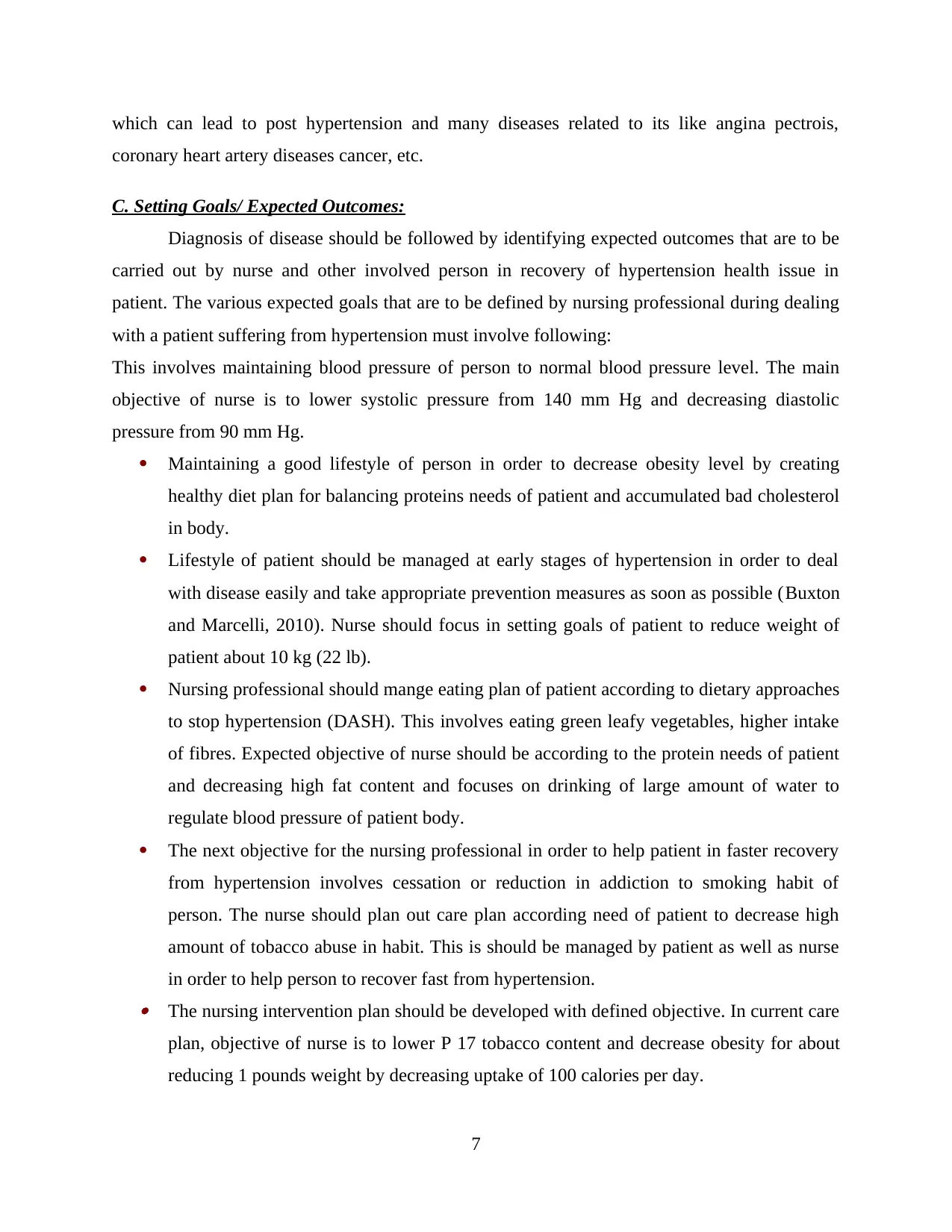
which can lead to post hypertension and many diseases related to its like angina pectrois,
coronary heart artery diseases cancer, etc.
C. Setting Goals/ Expected Outcomes:
Diagnosis of disease should be followed by identifying expected outcomes that are to be
carried out by nurse and other involved person in recovery of hypertension health issue in
patient. The various expected goals that are to be defined by nursing professional during dealing
with a patient suffering from hypertension must involve following:
This involves maintaining blood pressure of person to normal blood pressure level. The main
objective of nurse is to lower systolic pressure from 140 mm Hg and decreasing diastolic
pressure from 90 mm Hg.
Maintaining a good lifestyle of person in order to decrease obesity level by creating
healthy diet plan for balancing proteins needs of patient and accumulated bad cholesterol
in body.
Lifestyle of patient should be managed at early stages of hypertension in order to deal
with disease easily and take appropriate prevention measures as soon as possible (Buxton
and Marcelli, 2010). Nurse should focus in setting goals of patient to reduce weight of
patient about 10 kg (22 lb).
Nursing professional should mange eating plan of patient according to dietary approaches
to stop hypertension (DASH). This involves eating green leafy vegetables, higher intake
of fibres. Expected objective of nurse should be according to the protein needs of patient
and decreasing high fat content and focuses on drinking of large amount of water to
regulate blood pressure of patient body.
The next objective for the nursing professional in order to help patient in faster recovery
from hypertension involves cessation or reduction in addiction to smoking habit of
person. The nurse should plan out care plan according need of patient to decrease high
amount of tobacco abuse in habit. This is should be managed by patient as well as nurse
in order to help person to recover fast from hypertension. The nursing intervention plan should be developed with defined objective. In current care
plan, objective of nurse is to lower P 17 tobacco content and decrease obesity for about
reducing 1 pounds weight by decreasing uptake of 100 calories per day.
7
coronary heart artery diseases cancer, etc.
C. Setting Goals/ Expected Outcomes:
Diagnosis of disease should be followed by identifying expected outcomes that are to be
carried out by nurse and other involved person in recovery of hypertension health issue in
patient. The various expected goals that are to be defined by nursing professional during dealing
with a patient suffering from hypertension must involve following:
This involves maintaining blood pressure of person to normal blood pressure level. The main
objective of nurse is to lower systolic pressure from 140 mm Hg and decreasing diastolic
pressure from 90 mm Hg.
Maintaining a good lifestyle of person in order to decrease obesity level by creating
healthy diet plan for balancing proteins needs of patient and accumulated bad cholesterol
in body.
Lifestyle of patient should be managed at early stages of hypertension in order to deal
with disease easily and take appropriate prevention measures as soon as possible (Buxton
and Marcelli, 2010). Nurse should focus in setting goals of patient to reduce weight of
patient about 10 kg (22 lb).
Nursing professional should mange eating plan of patient according to dietary approaches
to stop hypertension (DASH). This involves eating green leafy vegetables, higher intake
of fibres. Expected objective of nurse should be according to the protein needs of patient
and decreasing high fat content and focuses on drinking of large amount of water to
regulate blood pressure of patient body.
The next objective for the nursing professional in order to help patient in faster recovery
from hypertension involves cessation or reduction in addiction to smoking habit of
person. The nurse should plan out care plan according need of patient to decrease high
amount of tobacco abuse in habit. This is should be managed by patient as well as nurse
in order to help person to recover fast from hypertension. The nursing intervention plan should be developed with defined objective. In current care
plan, objective of nurse is to lower P 17 tobacco content and decrease obesity for about
reducing 1 pounds weight by decreasing uptake of 100 calories per day.
7
⊘ This is a preview!⊘
Do you want full access?
Subscribe today to unlock all pages.

Trusted by 1+ million students worldwide
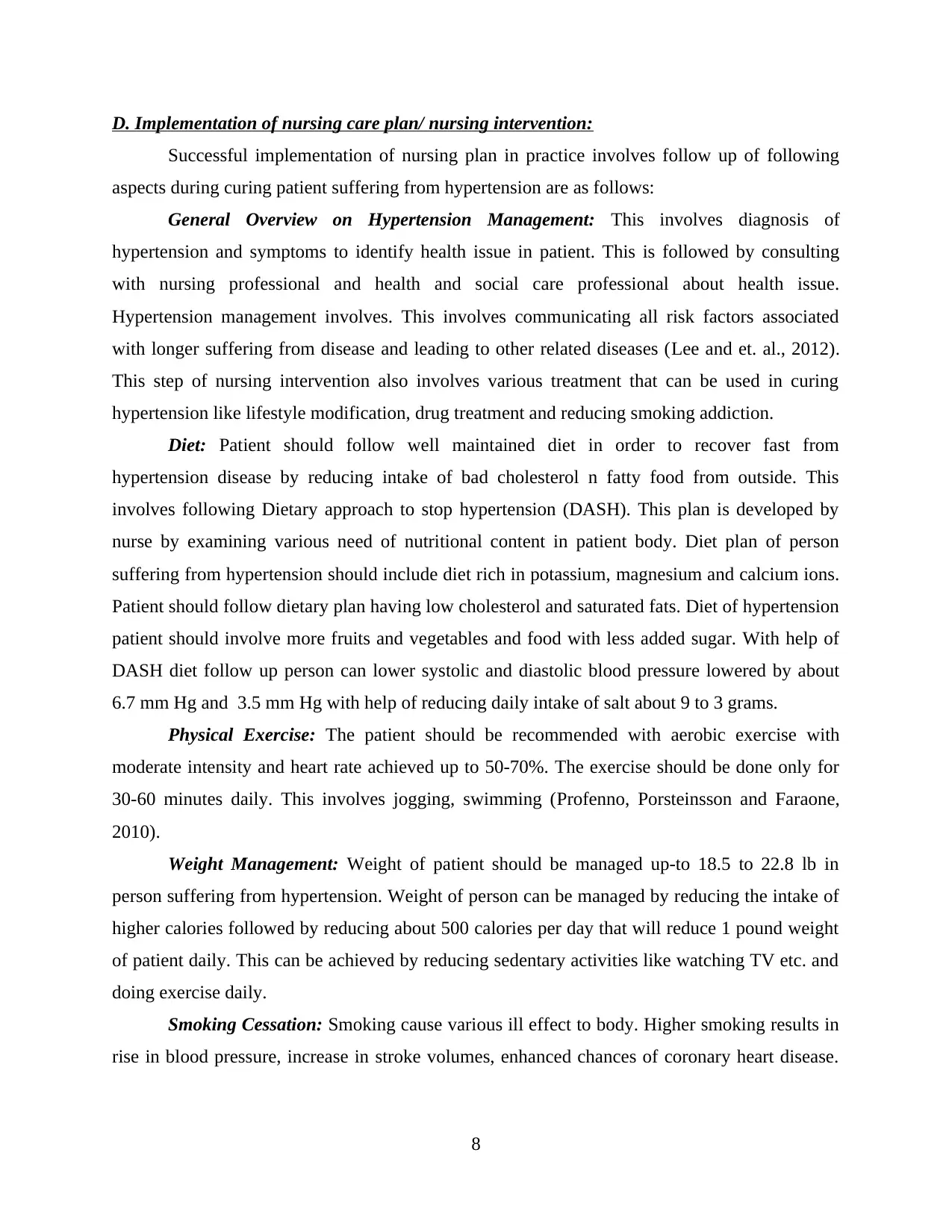
D. Implementation of nursing care plan/ nursing intervention:
Successful implementation of nursing plan in practice involves follow up of following
aspects during curing patient suffering from hypertension are as follows:
General Overview on Hypertension Management: This involves diagnosis of
hypertension and symptoms to identify health issue in patient. This is followed by consulting
with nursing professional and health and social care professional about health issue.
Hypertension management involves. This involves communicating all risk factors associated
with longer suffering from disease and leading to other related diseases (Lee and et. al., 2012).
This step of nursing intervention also involves various treatment that can be used in curing
hypertension like lifestyle modification, drug treatment and reducing smoking addiction.
Diet: Patient should follow well maintained diet in order to recover fast from
hypertension disease by reducing intake of bad cholesterol n fatty food from outside. This
involves following Dietary approach to stop hypertension (DASH). This plan is developed by
nurse by examining various need of nutritional content in patient body. Diet plan of person
suffering from hypertension should include diet rich in potassium, magnesium and calcium ions.
Patient should follow dietary plan having low cholesterol and saturated fats. Diet of hypertension
patient should involve more fruits and vegetables and food with less added sugar. With help of
DASH diet follow up person can lower systolic and diastolic blood pressure lowered by about
6.7 mm Hg and 3.5 mm Hg with help of reducing daily intake of salt about 9 to 3 grams.
Physical Exercise: The patient should be recommended with aerobic exercise with
moderate intensity and heart rate achieved up to 50-70%. The exercise should be done only for
30-60 minutes daily. This involves jogging, swimming (Profenno, Porsteinsson and Faraone,
2010).
Weight Management: Weight of patient should be managed up-to 18.5 to 22.8 lb in
person suffering from hypertension. Weight of person can be managed by reducing the intake of
higher calories followed by reducing about 500 calories per day that will reduce 1 pound weight
of patient daily. This can be achieved by reducing sedentary activities like watching TV etc. and
doing exercise daily.
Smoking Cessation: Smoking cause various ill effect to body. Higher smoking results in
rise in blood pressure, increase in stroke volumes, enhanced chances of coronary heart disease.
8
Successful implementation of nursing plan in practice involves follow up of following
aspects during curing patient suffering from hypertension are as follows:
General Overview on Hypertension Management: This involves diagnosis of
hypertension and symptoms to identify health issue in patient. This is followed by consulting
with nursing professional and health and social care professional about health issue.
Hypertension management involves. This involves communicating all risk factors associated
with longer suffering from disease and leading to other related diseases (Lee and et. al., 2012).
This step of nursing intervention also involves various treatment that can be used in curing
hypertension like lifestyle modification, drug treatment and reducing smoking addiction.
Diet: Patient should follow well maintained diet in order to recover fast from
hypertension disease by reducing intake of bad cholesterol n fatty food from outside. This
involves following Dietary approach to stop hypertension (DASH). This plan is developed by
nurse by examining various need of nutritional content in patient body. Diet plan of person
suffering from hypertension should include diet rich in potassium, magnesium and calcium ions.
Patient should follow dietary plan having low cholesterol and saturated fats. Diet of hypertension
patient should involve more fruits and vegetables and food with less added sugar. With help of
DASH diet follow up person can lower systolic and diastolic blood pressure lowered by about
6.7 mm Hg and 3.5 mm Hg with help of reducing daily intake of salt about 9 to 3 grams.
Physical Exercise: The patient should be recommended with aerobic exercise with
moderate intensity and heart rate achieved up to 50-70%. The exercise should be done only for
30-60 minutes daily. This involves jogging, swimming (Profenno, Porsteinsson and Faraone,
2010).
Weight Management: Weight of patient should be managed up-to 18.5 to 22.8 lb in
person suffering from hypertension. Weight of person can be managed by reducing the intake of
higher calories followed by reducing about 500 calories per day that will reduce 1 pound weight
of patient daily. This can be achieved by reducing sedentary activities like watching TV etc. and
doing exercise daily.
Smoking Cessation: Smoking cause various ill effect to body. Higher smoking results in
rise in blood pressure, increase in stroke volumes, enhanced chances of coronary heart disease.
8
Paraphrase This Document
Need a fresh take? Get an instant paraphrase of this document with our AI Paraphraser
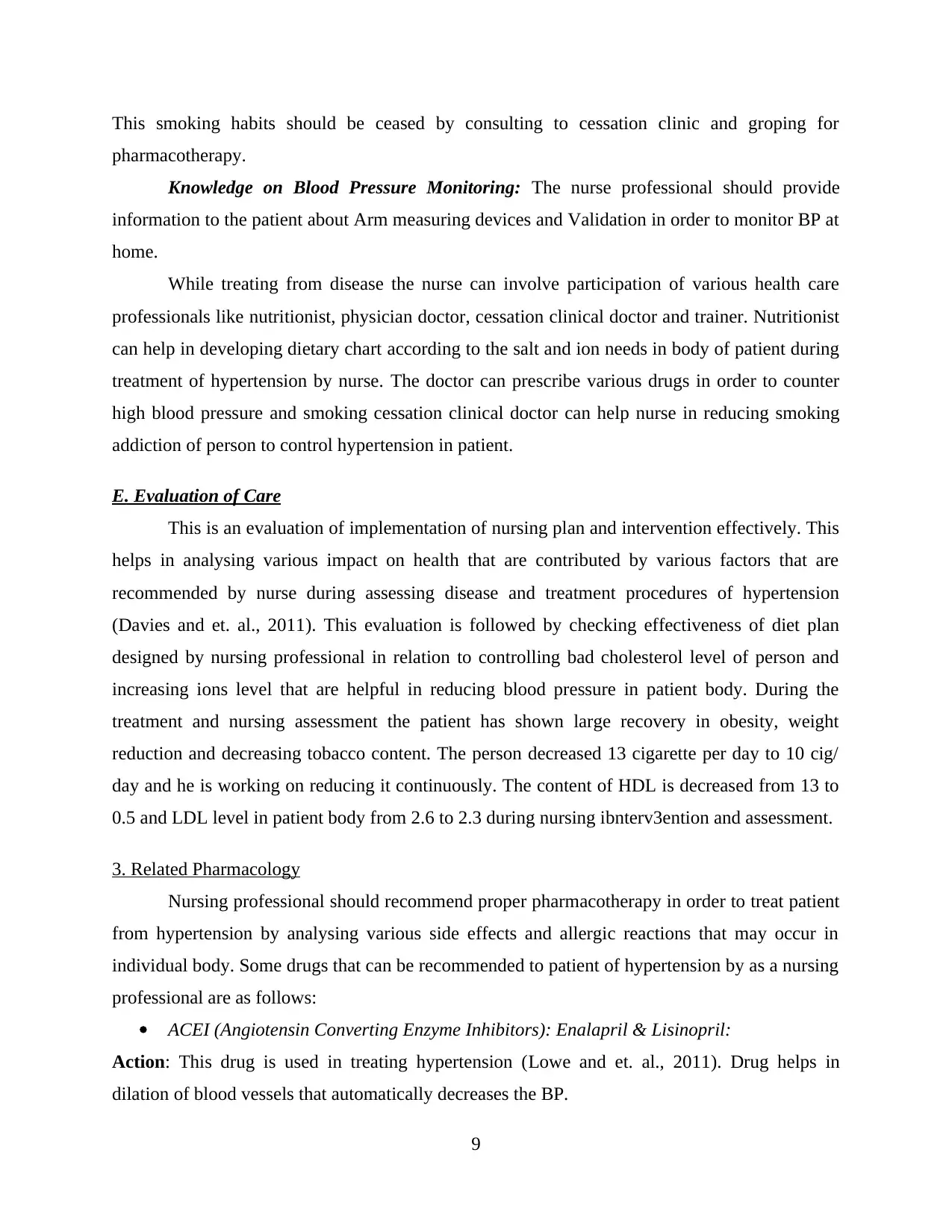
This smoking habits should be ceased by consulting to cessation clinic and groping for
pharmacotherapy.
Knowledge on Blood Pressure Monitoring: The nurse professional should provide
information to the patient about Arm measuring devices and Validation in order to monitor BP at
home.
While treating from disease the nurse can involve participation of various health care
professionals like nutritionist, physician doctor, cessation clinical doctor and trainer. Nutritionist
can help in developing dietary chart according to the salt and ion needs in body of patient during
treatment of hypertension by nurse. The doctor can prescribe various drugs in order to counter
high blood pressure and smoking cessation clinical doctor can help nurse in reducing smoking
addiction of person to control hypertension in patient.
E. Evaluation of Care
This is an evaluation of implementation of nursing plan and intervention effectively. This
helps in analysing various impact on health that are contributed by various factors that are
recommended by nurse during assessing disease and treatment procedures of hypertension
(Davies and et. al., 2011). This evaluation is followed by checking effectiveness of diet plan
designed by nursing professional in relation to controlling bad cholesterol level of person and
increasing ions level that are helpful in reducing blood pressure in patient body. During the
treatment and nursing assessment the patient has shown large recovery in obesity, weight
reduction and decreasing tobacco content. The person decreased 13 cigarette per day to 10 cig/
day and he is working on reducing it continuously. The content of HDL is decreased from 13 to
0.5 and LDL level in patient body from 2.6 to 2.3 during nursing ibnterv3ention and assessment.
3. Related Pharmacology
Nursing professional should recommend proper pharmacotherapy in order to treat patient
from hypertension by analysing various side effects and allergic reactions that may occur in
individual body. Some drugs that can be recommended to patient of hypertension by as a nursing
professional are as follows:
ACEI (Angiotensin Converting Enzyme Inhibitors): Enalapril & Lisinopril:
Action: This drug is used in treating hypertension (Lowe and et. al., 2011). Drug helps in
dilation of blood vessels that automatically decreases the BP.
9
pharmacotherapy.
Knowledge on Blood Pressure Monitoring: The nurse professional should provide
information to the patient about Arm measuring devices and Validation in order to monitor BP at
home.
While treating from disease the nurse can involve participation of various health care
professionals like nutritionist, physician doctor, cessation clinical doctor and trainer. Nutritionist
can help in developing dietary chart according to the salt and ion needs in body of patient during
treatment of hypertension by nurse. The doctor can prescribe various drugs in order to counter
high blood pressure and smoking cessation clinical doctor can help nurse in reducing smoking
addiction of person to control hypertension in patient.
E. Evaluation of Care
This is an evaluation of implementation of nursing plan and intervention effectively. This
helps in analysing various impact on health that are contributed by various factors that are
recommended by nurse during assessing disease and treatment procedures of hypertension
(Davies and et. al., 2011). This evaluation is followed by checking effectiveness of diet plan
designed by nursing professional in relation to controlling bad cholesterol level of person and
increasing ions level that are helpful in reducing blood pressure in patient body. During the
treatment and nursing assessment the patient has shown large recovery in obesity, weight
reduction and decreasing tobacco content. The person decreased 13 cigarette per day to 10 cig/
day and he is working on reducing it continuously. The content of HDL is decreased from 13 to
0.5 and LDL level in patient body from 2.6 to 2.3 during nursing ibnterv3ention and assessment.
3. Related Pharmacology
Nursing professional should recommend proper pharmacotherapy in order to treat patient
from hypertension by analysing various side effects and allergic reactions that may occur in
individual body. Some drugs that can be recommended to patient of hypertension by as a nursing
professional are as follows:
ACEI (Angiotensin Converting Enzyme Inhibitors): Enalapril & Lisinopril:
Action: This drug is used in treating hypertension (Lowe and et. al., 2011). Drug helps in
dilation of blood vessels that automatically decreases the BP.
9
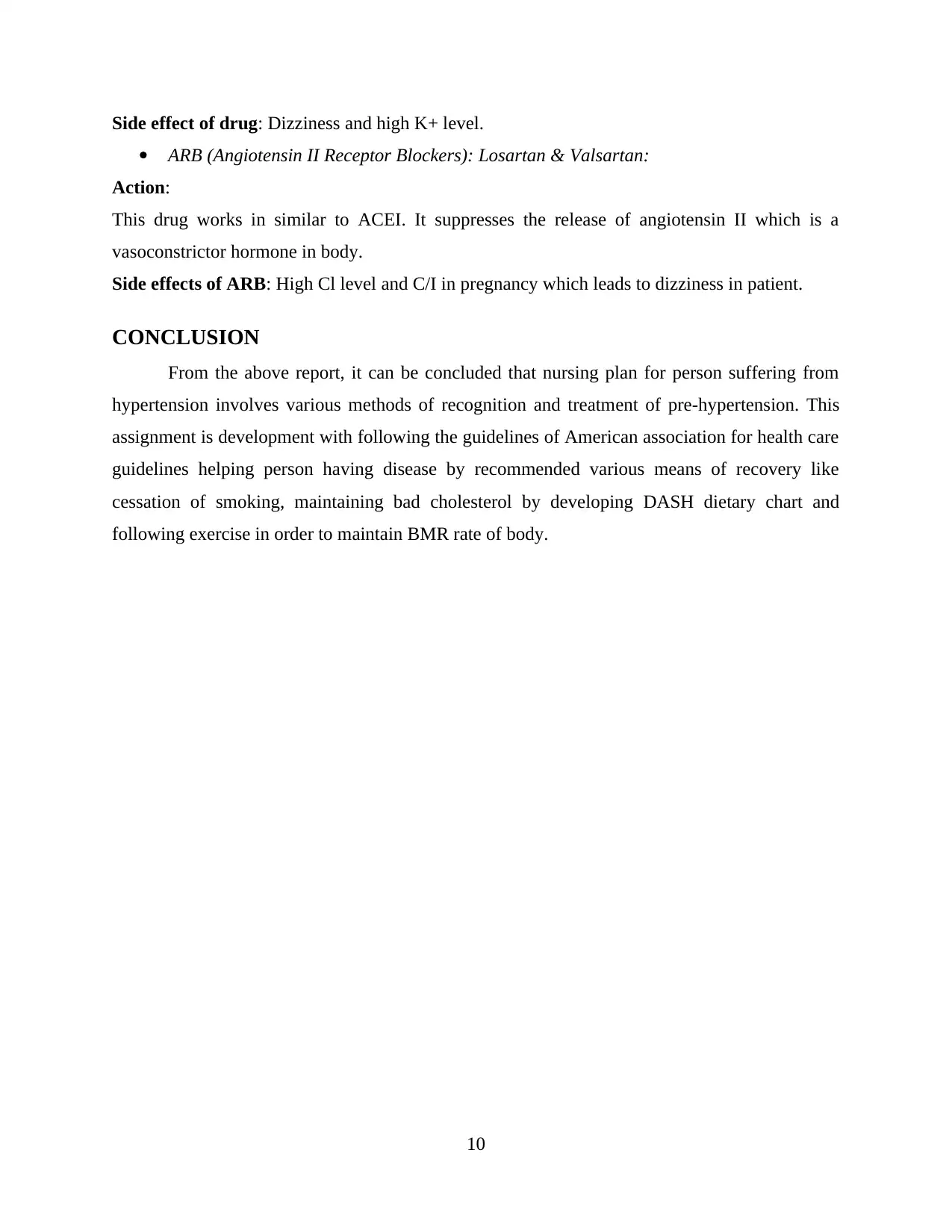
Side effect of drug: Dizziness and high K+ level.
ARB (Angiotensin II Receptor Blockers): Losartan & Valsartan:
Action:
This drug works in similar to ACEI. It suppresses the release of angiotensin II which is a
vasoconstrictor hormone in body.
Side effects of ARB: High Cl level and C/I in pregnancy which leads to dizziness in patient.
CONCLUSION
From the above report, it can be concluded that nursing plan for person suffering from
hypertension involves various methods of recognition and treatment of pre-hypertension. This
assignment is development with following the guidelines of American association for health care
guidelines helping person having disease by recommended various means of recovery like
cessation of smoking, maintaining bad cholesterol by developing DASH dietary chart and
following exercise in order to maintain BMR rate of body.
10
ARB (Angiotensin II Receptor Blockers): Losartan & Valsartan:
Action:
This drug works in similar to ACEI. It suppresses the release of angiotensin II which is a
vasoconstrictor hormone in body.
Side effects of ARB: High Cl level and C/I in pregnancy which leads to dizziness in patient.
CONCLUSION
From the above report, it can be concluded that nursing plan for person suffering from
hypertension involves various methods of recognition and treatment of pre-hypertension. This
assignment is development with following the guidelines of American association for health care
guidelines helping person having disease by recommended various means of recovery like
cessation of smoking, maintaining bad cholesterol by developing DASH dietary chart and
following exercise in order to maintain BMR rate of body.
10
⊘ This is a preview!⊘
Do you want full access?
Subscribe today to unlock all pages.

Trusted by 1+ million students worldwide
1 out of 16
Related Documents
Your All-in-One AI-Powered Toolkit for Academic Success.
+13062052269
info@desklib.com
Available 24*7 on WhatsApp / Email
![[object Object]](/_next/static/media/star-bottom.7253800d.svg)
Unlock your academic potential
Copyright © 2020–2026 A2Z Services. All Rights Reserved. Developed and managed by ZUCOL.




